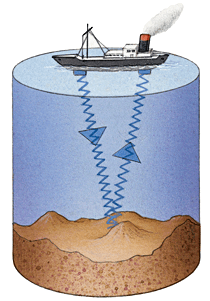DK Science: Acoustics
The science of how sound behaves, especially when it travels through our everyday world, is called acoustics. Sound waves normally travel in straight lines directly outwards from their source, but they do not always travel in that way. An object standing in the path of a sound wave can affect its movement. When a sound wave hits a hard object, the sound reflects back towards the source in the form of an ECHO. When soft objects get in the way, they can ABSORB the sound and stop it from travelling any further. Scientists use sound reflection and absorption to investigate places that they cannot visit, such as the depths of oceans and the interior of the Earth.
The Hollywood Bowl is a famous, open-air amphitheatre in California, USA. An amphitheatre is a bowl-shaped place that reflects sound naturally and evenly into the landscape around it. The Hollywood Bowl was carved into the side of a mountain at Bolton Canyon in the 1920s and can seat 20,000 people.
Music must sound clear in an auditorium, no matter where people are sitting in the audience. It should sound the same whether the hall is full or nearly empty. The curved shapes in modern concert halls are designed to help distribute the sound evenly to every seat in the auditorium.
If you shout at a distant wall, you can hear your voice return as a reflected sound wave, or echo. When the reflected sound wave has to travel some distance, it takes time to return and you hear it separately from the original sound. Sound waves that reflect off nearer objects return almost instantly. Our brains blend these waves with the original sound and we hear no echo.
Like many other sea creatures, dolphins use sound to find their way around, locate their companions, and discover sources of food. The clicking sounds they make are reflected back from the seabed and objects around them and are picked up by the dolphins’ long, bony heads. Using echoes to find things is known as echolocation.
Hard objects reflect sounds, but soft materials absorb sounds and silence them. When sound waves reach a soft material, their energy is soaked up and they travel no further. Things that absorb sound can be useful for reducing noise. Trees are sometimes planted by motorways so that their leaves will reduce the sound of traffic. Walls can be padded with soft materials to stop sound from travelling through them.
Engineers test loudspeakers and audio equipment in specially designed laboratories called anechoic chambers. The walls and ceiling are covered by spikes of soft foam that absorb sound and stop any echoes and reverberations (very fast echoes). Sounds made inside an anechoic chamber sound very dull or “dead”, which is why the chambers are also called “dead rooms”.

